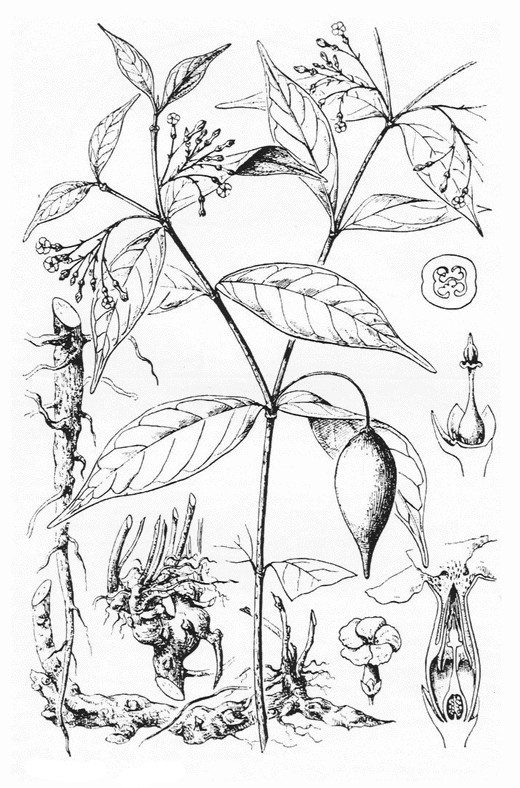Tabernanthe iboga Baill. - Apocynaceae - iboga, eboka, Iboga
Shrub or small tree, 1-2(-5)m high, native to the rainforests of western and central Africa; bark smooth, brown; leaves entire, elliptic, 7-13cm long and 2-5cm wide; flowers tiny, pale yellow to pale pink or white with pink dots, 5-12 together; fruit a long petioled berry, orange-yellow, ovoid, 2-4cm long, occuring as pending pairs.
„The Iboga tree is the central pillar of the Bwiti spiritual practice in West-Central Africa, mainly Gabon, Cameroon and the Republic of the Congo, which uses the alkaloid-containing roots of the plant in a number of ceremonies. Iboga is taken in massive doses by initiates of this spiritual practice, and on a more regular basis is eaten in smaller doses in connection with rituals and tribal dances, which is usually performed at night time.“ https://en.wikipedia.org/wiki/Tabernanthe_iboga
„Tabernanthe iboga is an apocynaceous shrub native to the forests of Gabon and the northern Congo. First described in the late 1800’s, it has been reasonably well studied by botanists. The roots of T. iboga contain several indole alkaloids, of which the most important, ibogaine, is a central stimulant and in large doses an hallucinogen. In Gabon, the roots are used in the initiation rites to a number of secret societies, of which the Bwiti is most famous. The plant remains to this day a central feature of local religion, and its spectacular effects have hampered native acceptance of Christianity in Gabon.“
[Tabernanthe iboga: an African narcotic plant of social importance., Pope, H. G., Economic Botany, Vol.23(2), 1969, 174-184]
„Ibogaine is an alkaloid derived from the African shrub Tabernanthe iboga. The psychoactive properties of ibogaine have been known for centuries. More recently, the drug has achieved some notoriety because of its putative benefits in the treatment of addiction. The pharmacology of this alkaloid is complex, and many targets have been identified, among them transporters for the neurotransmitters serotonin (5-hydroxytryptamine, 5-HT) and dopamine (DA). Ibogaine was shown to inhibit transport by 5-HT and DA transporters (SERT and DAT, respectively) with IC50 values in the micromolar range.“
http://www.ncbi.nlm.nih.gov/pmc/articles/PMC3365767/
„In the present paper, we report for the first time the tissue distribution of ibogaine and noribogaine, the main metabolite of ibogaine, in a 48-year-old Caucasian male, with a history of drug abuse, found dead at his home after a poisoning involving the ingestion of root bark from the shrub Tabernanthe iboga. Ibogaine and noribogaine were quantified in tissues and fluids using a fully validated liquid chromatography-electrospray mass spectrometry method. Apart from cardiac tissue, ibogaine and noribogaine were identified in all matrices investigated. The highest concentrations were found in spleen, liver, brain, and lung. The tissue/subclavian blood concentration ratios averaged 1.78, 3.75, 1.16, and 4.64 for ibogaine and 0.83, 2.43, 0.90, and 2.69 for noribogaine for spleen, liver, brain, and lung, respectively. Very low concentrations of the two drugs were found in the prostatic tissue. Both ibogaine and noribogaine are secreted in the bile and cross the blood-brain barrier. Four other compounds were detected in most of the studied matrices. One of them was identified as ibogamine.“
[Distribution of ibogaine and noribogaine in a man following a poisoning involving root bark of the Tabernanthe iboga shrub., Kontrimavičiūtė, V., Mathieu, O., Mathieu-Daudé, J.C., Vainauskas, P., Casper, T., Baccino, E., Bressolle, F.M., Journal of analytical toxicology, Vol.30(7), 2006, 434-440]
„Ibogaine is a naturally occurring psychoactive alkaloid extracted from the roots of the Tabernanthe iboga plant, which in alternative medicine is used to treat drug dependency. However, this upcoming, online advocated therapy can be dangerous due to its potentially lethal adverse effects. We present three cases in which toxic side effects were noted. We used the Naranjo scale to estimate the probability of a causal relationship between these effects and ibogaine. Findings in these three cases are suggestive of a causal relationship between the use of ibogaine and serious respiratory and cardiac problems (including lengthening of the QT interval). In our opinion it is of great importance that clinicians are aware of these potentially serious side effects and realise that widespread online marketing practices will give many more people access to ibogaine.“
[Life-threatening complications of ibogaine: three case reports., Paling, F.P., Andrews, L.M., Valk, G.D., Blom, H.J., drugs, 1, 2012, 2]

